NCERT Exemplar: Structural Organisation in Animals | Biology Class 11 - NEET PDF Download
MULTIPLE CHOICE QUESTIONS
Q.1. Which one of the following types of cell is involved in making of the inner walls of blood vessels?
(a) Cuboidal epithelium
(b) Columnar epithelium
(c) Squamous epithelium
(d) Stratified epithelium
Ans. (c)
Solution.
The squamous epithelium (pavement epithelium) is made up of a single thin layer of flattened cells with irregular boundaries. They are found in the walls of blood vessels and air sacs of lungs and are involved in forming a diffusion boundary.
Q.2. To which one of the following categories does adipose tissue belong?
(a) Epithelial
(b) Connective
(c) Muscular
(d) Neural
Ans. (b)
Solution.
Loose connective tissue has cells and fibres loosely arranged in a semifluid ground substance, for example, areolar tissue present beneath the skin. Adipose tissue is a type of loose connective tissue located mainly beneath the skin.
Q.3. Which one of the following is not a connective tissue?
(a) Bone
(b) Cartilage
(c) Blood
(d) Muscles
Ans. (d)
Solution.
Cartilage, bones and blood are various types of specialised connective tissues.
Q.4. Setae help in locomotion in earthworm but are not uniformly present in all the segments. They are present in
(a) 1st segment
(b) Last segment
(c) Clitellar segment
(d) 20th - 22nd segment
Ans. (d)
Solution.
Setae help in locomotion in earthworms; They are present in all segments except the 1st, last, and clitellar segments (14th to 16th).
Q.5. Which one of the following statements is true for cockroach?
(a) The number of ovarioles in each ovary are ten.
(b) The larval stage is called caterpillar.
(c) Anal styles are absent in females.
(d) They are ureotelic.
Ans. (c)
Solution.
- In cockroaches, females do not have anal styles.
- This characteristic helps to distinguish them from males.
Q.6. Match the following and choose the correct option
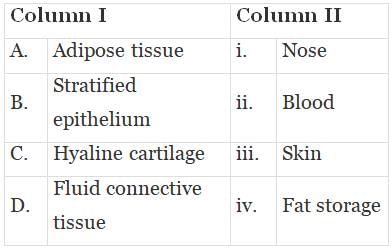
Options:
(a) A—(i), B—(ii), C—(iii), D—(iv)
(b) A—(iv), B—(iii), C—(i), D—(ii)
(c) A—(iii), B—(i), C—(iv), D—(ii)
(d) A—(ii), B—(i), C—(iv), D—(iii)
Ans. (b)

Q.7. Match the following and choose the correct option
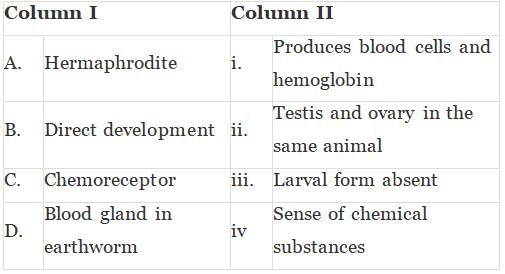
Options:
(a) A-ii, B-iii, C-iv, D-i
(b) A-iii, B-ii, C-iv, D-i
(c) A-i, B-iii, C-ii, D-i
(d) A-ii, B-iv, C-iii, D-i
Ans. (a)
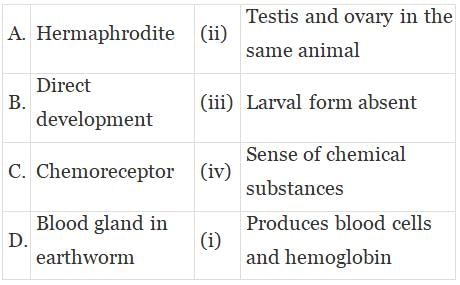
Q.8. Match the following with reference to cockroach and choose the correct option
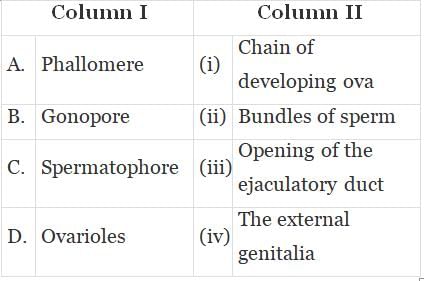
Option:
(a) A-iii, B-iv, C-ii, D-i
(b) A-iv, B-iii, C-ii, D-i
(c) A-iv, B-ii, C-iii, D-i
(d) A-ii, B-iv, C-iii, D-i
Ans. (b)
Solution.
Phallomere, also known as pseudopenis, is the external genitalia of the cockroach. The gonopore is a specific reproductive opening that serves as the exit for the ejaculatory duct. A spermatophore is a capsule of sperm produced by the male cockroach, which is transferred to the female during mating. Ovarioles are groups of eight ovarian tubules that form the ovary, containing a chain of developing ova.
Q.9. Match the following and choose the correct option

Option:
(a) A-iii, B-i, C-ii, D-iv
(b) A-ii, B-i, C-iv, D-iii
(c) A-iii, B-iv, C-ii, D-i
(d) A-iii, B-i, C-iv, D-ii
Ans. (d)

VERY SHORT ANSWER TYPE QUESTIONS
Q.1. State the number of segments in earthworm which are covered by a prominent dark band or clitellum.
Ans. The segments of the earthworm that are covered by a prominent dark band, known as the clitellum, are the:
- 14th segment
- 15th segment
- 16th segment
Q.2. Where are sclerites present in the Cockroach?
Ans. In the body of a cockroach, the exoskeleton features hardened plates known as sclerites. These are present in:
- Each body segment
- Providing structural support
- Contributing to the overall protection of the cockroach
Q.3. How many times do nymphs moult to reach the adult form of a cockroach?
Ans. The nymph of a cockroach undergoes approximately 13 moults before it transforms into the adult form.
Q.4. Identify the sex of a frog in which sound-producing vocal sacs are present.
Ans. Male frogs can be identified by the presence of sound-producing vocal sacs.
Q.5. Name the process by which a tadpole develops into an adult frog.
Ans. The process by which a tadpole develops into an adult frog is called metamorphosis.
Q.6. What is the scientific term given to earthworm’s body segments?
Ans. The scientific term for the body segments of an earthworm is metameres.
Q.7. A muscle fibre tapers at both ends and does not show striations. Name the muscle fibre.
Ans. Smooth muscle fibre
Q.8. Name the different cell junctions found in tissues.
Ans.
(a) Tight Junctions
(b) Adhering Junctions
(c) Gap Junctions
Q.9. Give two identifying features of an adult male frog.
Ans.
- Vocal sacs: Male frogs have vocal sacs that allow them to produce sounds, especially during mating.
- Thumb pads: They possess copulatory pads on the first digit of their forelimbs, which are used to grasp females during mating.
Q.10. Which mouth part of a cockroach is comparable to our tongue?
Ans. The mouth part of a cockroach that is similar to our tongue is called the hypopharynx.
Q.11. The digestive system of a frog is made of the following parts. Arrange them in an order beginning from the mouth.
Mouth, oesophagus, buccal cavity, stomach, intestine, cloaca, rectum, cloacal aperture
Ans. Mouth, buccal cavity, oesophagus, stomach, intestine, rectum, cloaca and cloacal aperture.
Q.12. What is the difference between cutaneous and pulmonary respiration?
Ans. Frogs use two methods for respiration, depending on their environment:
- Cutaneous respiration: This occurs in water, where the skin functions as a respiratory organ. Oxygen dissolved in the water is absorbed through the skin by diffusion.
- Pulmonary respiration: On land, frogs use their lungs, buccal cavity, and skin for breathing. The lungs, which are pink, sac-like structures located in the thorax, facilitate this process.
Air enters through the nostrils into the buccal cavity and then moves to the lungs. During periods of aestivation and hibernation, gas exchange can also occur through the skin.
Q.13. Special venous connections between the liver and intestine, and between the kidney and intestine, are found in the frog. What are they called?
Ans. The special venous connections in frogs are:
- Hepatic portal system: Connects the liver and intestine.
- Renal portal system: Connects the kidneys and the lower parts of the body.
SHORT ANSWER TYPE QUESTIONS
Q.1. Give the location of hepatic caeca in a cockroach. What is their function?
Ans. A ring of 6-8 blind tubules, known as hepatic caeca, is located at the junction of the foregut and midgut in a cockroach. The functions of the hepatic caeca include:
- Secreting digestive juices.
- Assisting in the digestion of food.
Q.2. Frogs are beneficial for mankind. Justify the statement.
Ans. Frogs are beneficial for mankind because they play several important roles in our ecosystem:
- They consume crop pests, helping to protect agricultural produce.
- Frogs maintain the ecological balance as they are vital links in the food chain.
- In some cultures, their legs are considered a delicacy.
Q.3. The body of sponges does not possess tissue-level organisation, though it is made of thousands of cells. Comment.
Ans. Sponges are unique among multicellular animals as they do not have a tissue-level of organisation. Instead, their cells are organised into loose aggregates, which means:
- They exhibit a cellular level of organisation.
- Cells perform some specialised functions, but there is no true division of labour.
- Unlike complex animals, sponges lack organised tissues that work together.
Thus, the body of sponges does not possess a tissue-level of organisation.
Q.4. Structural organisation in animals attains different levels as cell—organ— organ system. What is missing in this chain? Mention the significance of such an organisation.
Ans. Tissue is missing in this chain. In multicellular animals:
- A group of similar cells, along with intercellular substances, performs a specific function. This organisation is called tissue.
- Tissues are arranged in specific proportions and patterns to form organs such as the stomach, lungs, heart, and kidneys.
- When two or more organs work together to perform a common function through physical and/or chemical interactions, they form an organ system, e.g., the digestive system or respiratory system.
This hierarchical structure of cells, tissues, organs, and organ systems:
- Facilitates a division of labour, allowing each component to specialise in its function.
- Enhances the overall survival and efficiency of the organism.
Q.5. Stratified epithelial cells have limited role in secretion. Justify their role in our skin.
Ans. Stratified epithelium is made of more than one layer of cells and thus has a limited role in secretion and absorption. Their main function is to provide protection against chemical and mechanical stresses. They cover the dry surface of the skin.
Q.6. How does a gap junction facilitate intercellular communication?
Ans. Gap junctions facilitate the cells to communicate with each other by connecting the cytoplasm of adjoining cells, for rapid transfer of ions, small molecules and sometimes big molecules.
Q.7. Why are blood, bone and cartilage called connective tissue?
Ans. Blood, bone and cartilage are called connective tissue because of their special function of linking and supporting other tissues/organs of the body.
Q.8. Why are neurons called excitable cells? Mention special features of the membrane of the neuron?
Ans. Neurons are called excitable cells because when a neuron is suitably stimulated, an electrical disturbance is generated which swiftly travels along its plasma membrane. Arrival of the disturbance at the neuron’s endings, or output zone, triggers events that may cause stimulation or inhibition of adjacent neurons and other cells.
Q.9. Why earthworm is called the friend of farmer?
Ans. Earthworms are known as ‘friends of farmers’ because they make burrows in the soil and make it porous which helps in respiration and penetration of the developing plant roots. The process of increasing fertility of soil by the earthworms is called vermicomposting.
Q.10. How do you distinguish between dorsal and ventral surface of the body of earthworm?
Ans. The dorsal surface of the body of earthworm is marked by a dark median mid dorsal line (dorsal blood vessel) along the longitudinal axis of the body. The ventral surface is distinguished by the presence of genital openings (pores).
Q.11. Correct the wrong statements among the following.
(a) In earthworm, a single male genital pore is present.
(b) Setae help in locomotion of earthworm.
(c) Muscular layer in the body wall of earthworm is made up of only circular muscles.
(d) Typhlosole is the part of intestine of earthworm.
Ans.
(a) In earthworm, a pair of male genital pores is present.
(b) Correct statement
(c) Muscular layer in the body wall of earthworm is made up of circular muscles and longitudinal muscles.
(d) Correct statement
Q.12. Why nephridia in earthworm that are basically similar in structure classified into three types? Mention the names of each.
Ans. The excretory organs occur as segmentally arranged coiled tubules called nephridia (sing.: nephridium).
They are of three types:
(i) septal nephridia, present on both the sides of intersegmental septa of segment 15 to the last that open into intestine
(ii) integumentary nephridia, attached to lining of the body wall of segment 3 to the last that open on the body surface
(iii) pharyngeal nephridia, present as three paired tufts in the 4th, 5th and 6th segments. These different types of nephridia are basically similar in structure.
Nephridia regulate the volume and composition of the body fluids. A nephridium starts out as a funnel that collects excess fluid from coelomic chamber. The funnel connects with a tubular part of the nephridium which delivers the wastes through a pore to the surface in the body wall into the digestive tube.
Q.13. Common names of some animals are given in Column A, write their scientific name in Column B.
| Column A | Column B | |
| a. | Tiger | _____ |
| b. | Peacock | _____ |
| c. | Housefly | _____ |
Ans.
| Column A | Column B | |
| a. | Tiger | Panthera tigris |
| b. | Peacock | Pavo cristatus |
| c. | Housefly | Musca domestica |
Q.14. Complete the following statement :
(a) In cockroach grinding of food particle is performed by _______
(b) Malpighian tubules help in removal of ____________
(c) Hind gut of cockroach is differentiated into ______________
(d) In cockroach blood vessels open into spaces called _________
Ans.
(a) In Cockroach, grinding of food particles is performed by gizzard.
(b) Malpighian tubules help in the removal of nitrogenous waste products.
(c) Hind gut of the Cockroach is differentiated into ileum, colon and rectum.
(d) In Cockroach, blood vessels open into spaces called sinuses.
Q.15. Mention special features of eye in Cockroach.
Ans. The compound eyes are situated at the dorsal surface of the head. Each eye consists of about 2000 hexagonal ommatidia (sing.: ommatidium). With the help of several ommatidia, a cockroach can receive several images of an object. This kind of vision is known as mosaic vision with more sensitivity but less resolution, being common during night (hence called nocturnal vision).
Q.16. Frog is a poikilotherm, exhibits camouflage and undergoes aestivation and hibernation, how are all these beneficial to it?
Ans. Frog have the ability to change colour which hides them from their enemies (camouflage). This protective colouration is called mimicry.Frogs are not seen during peak summer and winter. During this period they take shelter in deep burrows to protect them from extreme heat and cold. This is called as summer sleep (aestivation) and winter sleep (hibernation).
Q.17. Write the functions in brief in column B, appropriate to the structures given in column A.
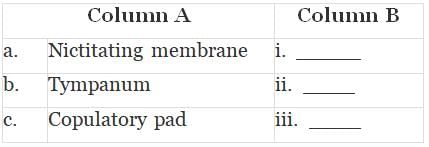
Ans.
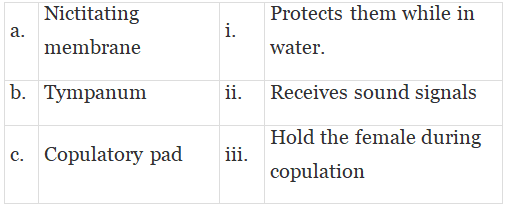
Q.18. Write the appropriate type of tissues in column B according to the functions mentioned in column A.
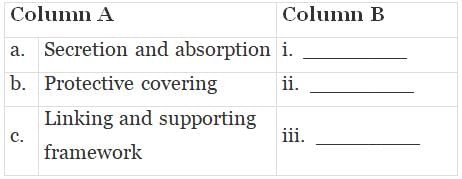
Ans.

Q.19. Using appropriate examples, differentiate between false and true body segmentation.
Ans.
(i) Metamerism: In some animals, the body is externally and internally divided into segments with a serial repetition of at least some organs. For example, in an earthworm, the body shows this pattern called metameric segmentation and the phenomenon is known as metamerism or true segmentation.
Metamerism is found in 3 animal phyla—Annelida, Arthropoda and Chordata.
(ii) Pseudometamerism or false segmentation: In tapeworms, the body is externally divisible into parts called proglottis. They develop from the neck but are not embryonic in origin; this segmentation is called pseudometamerism.
Q.20. What is special about the tissue present in the heart?
Ans. Cardiac muscle tissue is a contractile tissue present only in the heart. Cell junctions fuse the plasma membranes of cardiac muscle cells and make them stick together. Communication junctions (intercalated discs) at some fusion points allow the cells to contract as a unit, i.e. when one cell receives a signal to contract, its neighbours are also stimulated to contract.
LONG ANSWER TYPE QUESTIONS
Q.1. Classify and describe epithelial tissue on the basis of structural modifications of cells.
Ans. There are two types of epithelial tissues, namely simple epithelium and compound epithelium. Simple epithelium is composed of a single layer of cells and functions as a lining for body cavities, ducts, and tubes. The compound epithelium consists of two or more cell layers and has a protective function, as it does in our skin.
(i) Squamous Epithelium: The squamous epithelium is made of a single thin layer of flattened cells with irregular boundaries. They are found in the walls of blood vessels and air sacs of the lungs and are involved in functions like forming a diffusion boundary.
(ii)Cuboidal Epithelium: The cuboidal epithelium is composed of a single layer of cube-like cells. This is commonly found in ducts of glands and tubular parts of nephrons in the kidneys, and its main functions are secretion and absorption. The epithelium of the proximal convoluted tubule (PCT) of the nephron in the kidney has microvilli.
(iii) Columnar Epithelium: The columnar epithelium is composed of a single layer of tall and slender cells. Their nuclei are located at the base. The free surface may have microvilli. They are found in the lining of stomach and intestine and help in secretion and absorption.
(iv) Compound epithelium: The Compound Epithelium is made of more than one layer (multi-layered) of cells and thus has a limited role in secretion and absorption. Their main function is to provide protection against chemical and mechanical stresses. They cover the dry surface of the skin, the moist surface of the buccal cavity, pharynx, inner lining of ducts of salivary glands and of pancreatic ducts.
Q.2. Write down the common features of the connective tissue. On the basis of structure and function, differentiate between bones and cartilages.
Ans.
Connective Tissues
- Connective tissues are most abundant and widely distributed in the body of complex animals.
- They are named connective tissues because of their special function of linking and supporting other tissues/organs of the body.
- They range from soft connective tissues to specialised types, which include cartilage, bone, adipose, and blood.
- In all connective tissues except blood, the cells secrete fibres of structural proteins called collagen or elastin.
- The fibres provide strength, elasticity and flexibility to the tissue.
- These cells also secrete modified polysaccharides, which accumulate between cells and fibres and act as matrix (ground substance).
Cartilage
- The intercellular material of cartilage is solid and pliable and resists compression.
- Cells of this tissue (chondrocytes) are enclosed in small cavities within the matrix secreted by them.
- Most of the cartilages in vertebrate embryos are replaced by bones in adults.
- Cartilage is present in the tip of the nose, outer ear joints, between adjacent bones of the vertebral column, limbs and hands in adults.
Bones
- Bones have a hard and non-pliable ground substance rich in calcium salts and collagen fibres, which give bone its strength.
- It is the main tissue that provides a structural frame to the body.
- Bones support and protect softer tissues and organs.
- The bone cells (osteocytes) are present in the spaces called lacunae.
- Limb bones, such as the long bones of the legs, serve weight-bearing functions.
- They also interact with skeletal muscles attached to them to bring about movements.
- The bone marrow in some bones is the site of production of blood cells.
Q.3. Comment upon the gametic exchange in earthworm during mating.
Ans.
- A mutual exchange of sperm occurs between two worms during mating.
- One worm has to find another worm, and they mate, juxtaposing opposite gonadal openings, exchanging packets of sperm called spermatophores.
- Mature sperm and egg cells, and nutritive fluid are deposited in cocoons produced by the gland cells of the clitellum.
- Fertilisation and development occur within the cocoons which are deposited in soil.
- The ova (eggs) are fertilised by the sperm cells within the cocoon which then slips off the worm and is deposited in or on the soil.
- The cocoon holds the worm embryos.
- After about 3 weeks, each cocoon produces two to twenty baby worms with an average of four.
- Development of earthworms is direct, i.e. there is no larva formed.
Q.4. Explain the digestive system of the Cockroach with the help of a labelled sketch.
Ans. The digestive system consists of the alimentary canal and the digestive glands. The alimentary canal of cockroach is divided into foregut, midgut and hindgut.
(i) Foregut: The mouth opens into a short tubular pharynx, leading to a narrow tubular passage, the oesophagus, which opens into a sac like crop used for storing food. The crop is followed by a gizzard or proventriculus. Gizzard consists of six chitinous plates called teeth which helps in grinding food. The entire foregut is lined by cuticle. A ring of six to eight blind tubular structures called hepatic or gastric caecae is present at the junction of the foregut and midgut, which secrete digestive juice.
(ii) Midgut: At the junction of midgut and hindgut is present another ring of yellow colored thin filamentous malpighian tubules which help in the removal of excretory products from hemolymph.
(iii) Hindgut: The hindgut is broader than midgut and is differentiated into ileum, colon and rectum. The rectum opens out through anus.
 Digestive system of Cockraoach
Digestive system of Cockraoach
Q.5. Draw a neat and well-labelled diagram of the male reproductive system of a frog.
Ans.  Male Reproductive system of a Frog
Male Reproductive system of a Frog
|
169 videos|524 docs|136 tests
|
FAQs on NCERT Exemplar: Structural Organisation in Animals - Biology Class 11 - NEET
| 1. What is the study of structural organization in animals? |  |
| 2. How is the structural organization of animals relevant to the NEET exam? |  |
| 3. What are some examples of structural organization in animals? |  |
| 4. How can understanding the structural organization in animals help in medical diagnosis and treatment? |  |
| 5. What are the different levels of structural organization in animals? |  |

















